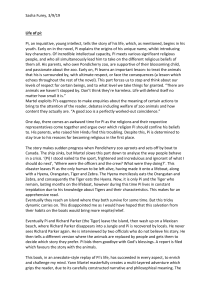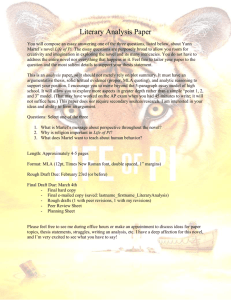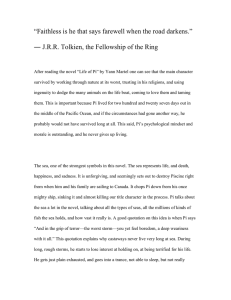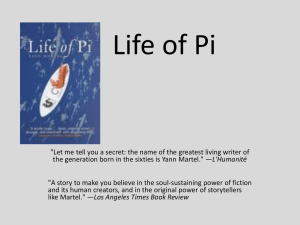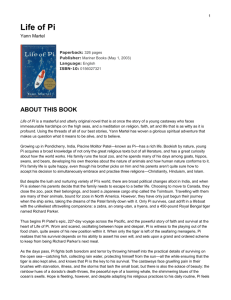Life of Pi READING QUESTIONS
advertisement
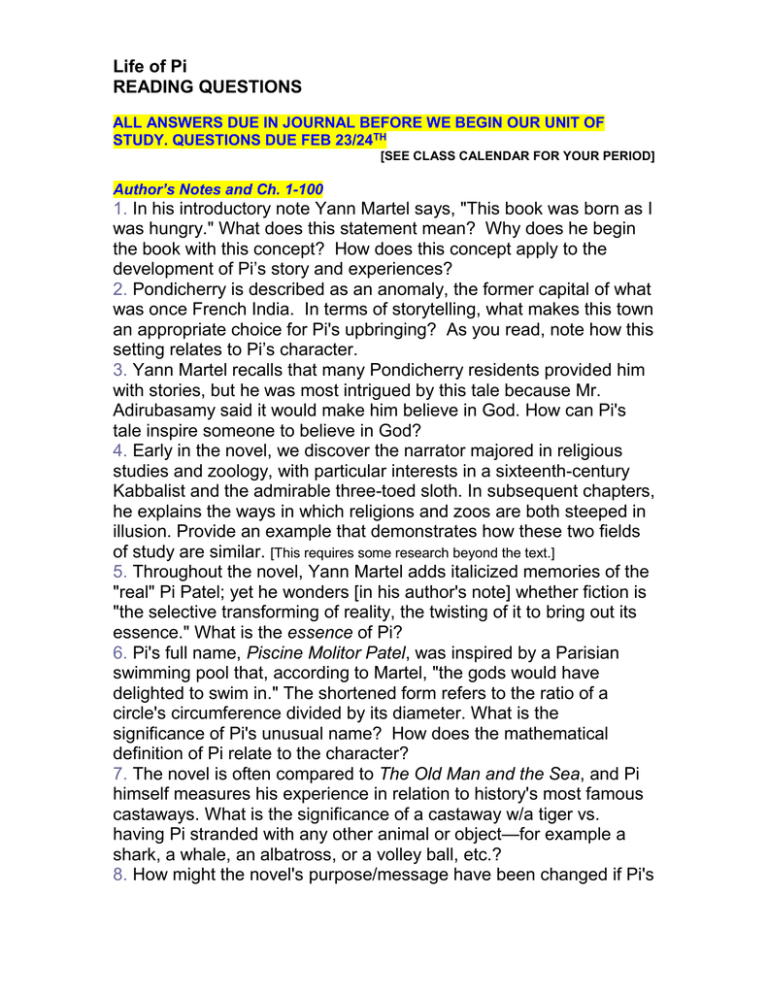
Life of Pi READING QUESTIONS ALL ANSWERS DUE IN JOURNAL BEFORE WE BEGIN OUR UNIT OF STUDY. QUESTIONS DUE FEB 23/24TH [SEE CLASS CALENDAR FOR YOUR PERIOD] Author’s Notes and Ch. 1-100 1. In his introductory note Yann Martel says, "This book was born as I was hungry." What does this statement mean? Why does he begin the book with this concept? How does this concept apply to the development of Pi’s story and experiences? 2. Pondicherry is described as an anomaly, the former capital of what was once French India. In terms of storytelling, what makes this town an appropriate choice for Pi's upbringing? As you read, note how this setting relates to Pi’s character. 3. Yann Martel recalls that many Pondicherry residents provided him with stories, but he was most intrigued by this tale because Mr. Adirubasamy said it would make him believe in God. How can Pi's tale inspire someone to believe in God? 4. Early in the novel, we discover the narrator majored in religious studies and zoology, with particular interests in a sixteenth-century Kabbalist and the admirable three-toed sloth. In subsequent chapters, he explains the ways in which religions and zoos are both steeped in illusion. Provide an example that demonstrates how these two fields of study are similar. [This requires some research beyond the text.] 5. Throughout the novel, Yann Martel adds italicized memories of the "real" Pi Patel; yet he wonders [in his author's note] whether fiction is "the selective transforming of reality, the twisting of it to bring out its essence." What is the essence of Pi? 6. Pi's full name, Piscine Molitor Patel, was inspired by a Parisian swimming pool that, according to Martel, "the gods would have delighted to swim in." The shortened form refers to the ratio of a circle's circumference divided by its diameter. What is the significance of Pi's unusual name? How does the mathematical definition of Pi relate to the character? 7. The novel is often compared to The Old Man and the Sea, and Pi himself measures his experience in relation to history's most famous castaways. What is the significance of a castaway w/a tiger vs. having Pi stranded with any other animal or object—for example a shark, a whale, an albatross, or a volley ball, etc.? 8. How might the novel's purpose/message have been changed if Pi's sole surviving animal were the zebra or the hyena? (We assume that if the hyena had been the only surviving animal, Pi would not have lived to tell us his story.) 9. In chapter 23, Pi sparks a lively debate when all three of his spiritual advisors try to claim him. At the heart of this confrontation is Pi's insistence that he cannot accept exclusively Hinduism, Christianity, or Islam; he can only be content with all three. What is Pi seeking that can solely be attained by this apparent contradiction? What is the significance of his seeking answers with these religious beliefs? How are they similar? Different? 10. What do you make of Pi's assertion at the beginning of chapter 16 that we are all "in limbo, without religion, until some figure introduces us to God?" Is Pi's piousness a response to his father's atheism or something else? Explain with examples from the text. 11. Among Yann Martel's gifts is a rich descriptive palette. Regarding religion, he observes the green elements that represent Islam and the orange tones of Hinduism. What color would Christianity be, according to Pi's perspective? Why? 12. How do human beings reflect animal behavior as observed by Pi? What do Pi's strategies for dealing with Richard Parker teach us about confronting fear? 13. Besides the loss of his family and possessions, what else did Pi lose when the Tsimtsum sank? What did he gain in the loss? 14. How do Pi’s traumatic experiences influence his coming of age? Note the one experience you feel is the most significant in forming his view of life—explain why. 15. How does Mr. Patel's zoo keeping abilities compare to his parenting skills? Describe the scene in which his tries to teach his children a lesson in survival by arranging for them to watch a tiger devour a goat. Did this in any way prepare Pi for the most dangerous experience of his life? Was there a better way he could have given them the same lesson w/o the trauma? 16. Why did Pi [at first] try so hard to save Richard Parker? Was this instinct or stupidity? What does this say about Pi’s resolve? 17. Pi imagines his brother would have teasingly called him Noah. How does Pi's voyage compare to the biblical story of Noah, who was spared from the flood while God washed away the sinners? [Do some research if you are not familiar with this biblical story that is often referenced in classic literature.] 18. Is Life of Pi better categorized as a tragedy, romance, or comedy? Defend your response by referencing the key theme/s [universal] you feel support your response on the appropriate genre for this story. 19. Do you agree with Pi's opinion that a zoo is more like a suburb than a jail? Why does he make this comparison? What does this comparison say about his thoughts of how animals are “contained” by humans? 20. Provide a brief summary including your reaction to Pi's interview by the Japanese transport ministers [who insisted on knowing the “truth.”] Did you ever believe Pi's mother, along with a sailor and a cannibalistic cook, had been in the lifeboat with him instead of the animals? Is the whole experience Pi has on the boat real or not? Defend your response with logical analysis of the story Pi tells. 21. The opening scene occurs after Pi's ordeal has ended. Discussing his work in the first chapter, Pi says that a necktie is a noose, and he mentions some of the things that he misses about India (in spite of his love for Canada). Comparing how the novel starts, and then ends…would you say this novel has a happy ending? How does the grown-up version of Pi contrast with his “little-boy” scenes? NOVEL OVERVIEW. SELECT 3 OF THE FOLLOWING QUESTIONS/PROMPTS TO ADDRESS IN YOUR JOURNAL [3 PTS EACH]: 1. As Pi’s father says, when he is explaining the ferocity of the zoo animals to his sons, “Life will defend itself no matter how small it is.” In what ways does Pi defend himself in this novel? 2. With his stories about zoos and zoology, Pi teaches us that the ability to adapt is crucial not only to animals but to humans, and is rooted in the will to survive. How do Pi’s theories of zoo keeping play out on the lifeboat? Does Pi go through a transformation on his journey? What does he learn? 3. Our author discovers the story of Pi Patel after an elderly man in an Indian coffee house tells him, “I have a story that will make you believe in God.” As a young man, Pi shocks his family and local religious officials by embracing Christianity, Hinduism, and Islam, and sees no reason to pick just one. And on the lifeboat, it is God that Pi turns to in his despair. Describe the role of religion, and religious stories, in this novel. 4. When Pi meets with the Japanese officials at the end of his journey and tells them his story, they do not believe him and ask what really happened. Pi provides them with a new story, one of “dry, yeast less factuality,” without animals, and then asks which one they prefer. Describe the nature of storytelling and belief in relation to Life of Pi, and to life. 5. “As for hearing, the sloth is not so much deaf as uninterested in sound.” “To choose doubt as a philosophy of life is akin to choosing immobility as a means of transportation.” As a story of death, loss, fear and destruction, Life of Pi has at its heart a number of very tragic events. However, one of the most pervasive elements of the novel is its matter-of-fact use of humor. Why does Martel use humor to relay the events of Pi’s experiences? What is the effect of humor on you, as a reader of this story? What does the use of humor help you understand or accept? 6. Near the end of Life of Pi, Pi and Richard Parker come ashore on a free-floating island comprised entirely of algae and inhabited only by multiple meerkats. Why does Pi decide to leave the island? What is the significance of this story? Is there a difference between survival and life? 7. Whereas the bulk of this novel is told by Pi Patel “in his voice and through his eyes,” our author tells us we also see the current-day Pi through the eyes of the author, and read “excerpts from the verbatim transcript” of the young Pi’s interview with the Japanese officials. Why? Discuss the effect of and possible reasons for the narrative structure of this novel. Identify the POV used and any shifts in style. 8. The Author’s Note ends with what seems to be a call to arms: “If we, citizens, do not support our artists, then we sacrifice our imagination on the altar of crude reality and we end up believing in nothing and having worthless dreams.” In reviews of Life of Pi, Yann Martel has been equally and abundantly praised for his realism and his great imagination. Do you see a conflict between these approaches to writing fiction? What is the role of “truth” in fiction? 9. In Life of Pi we know Richard Parker to be a 450-pound Royal Bengal tiger mistakenly named after the hunter who captured him, and Pi’s companion during his seven months at sea. But there are further nautical stories involving Richard Parkers, outside of this book: Edgar Allan Poe’s Richard Parker was eaten by his shipmates in the novel The Adventures of Arthur Gordon Pym, a real-life cabin boy named Richard Parker was eaten by his fellow castaways after the sinking of the Mignonette in the 1870s, and so on. Why might Yann Martel have chosen this common character name for his tiger and this novel? Describe the importance of names and naming in Life of Pi.
